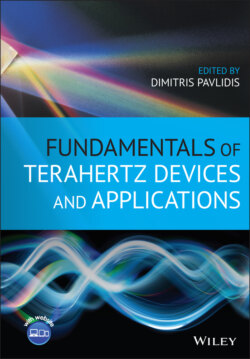Читать книгу Fundamentals of Terahertz Devices and Applications - Группа авторов - Страница 26
2.4.1 Analysis of the Leaky‐wave Propagation Constant
ОглавлениеIn this section, we will analyze the propagation constant, kρlw, of the leaky waves propagating in the air cavity. For this evaluation the propagation constant, we will approximate the aperture field of Fabry–Perot leaky‐wave antennas as and use the approximate analytical equations provided in [46]. The value of this propagation constant depends on the impedance, ZL, seen from the top of the half‐wavelength cavity in the equivalent transmission line model. For a dielectric quartz (being ) super‐layer with a quarter wavelength thickness, this impedance is . The pointing direction of the leaky‐wave modes is in this case 17°. If we need a more directive antenna, a lower ZL is required in order to achieve less attenuated mode, implying stronger multiple‐reflections (i.e. more resonant), and thus, less bandwidth.
If instead of a dielectric super‐layer stratification we consider an infinite layer of silicon, the impedance seen on top of the cavity is . Since , the impedances associated with the quartz super‐layer and the infinite silicon layer are comparable and consequently, the leaky‐wave propagation constants. Figure 2.13 shows the real and imaginary parts of the propagation constant for the three possible propagating modes: two TM and one TE. On the left axis of the figure, the propagation constants are normalized to the free space propagation constant k0. The main mode TM1 and TE1 points towards approximately 18°, whereas the non‐desired mode TM0 radiates towards larger angles, i.e. 81°. However, if we calculate the pointing angles inside the dielectric, from the right axis of the figure, where the propagation constant is normalized to instead of k0, we obtain values of about 6° for the main poles, which will translate into εr times more directive pattern inside the dielectric medium without compromising the bandwidth.
Figure 2.13 Real and imaginary parts of the propagation constants klw of the leaky‐wave modes present in an air cavity (h = 275 μm) and infinite silicon dielectric medium. On the left axis, klw is normalized to the free space propagation constant, k0, whereas klw (shown in the right axis) is normalized to the propagation constant in the dielectric, .
Figure 2.14 Input reflection coefficient of a waveguide loaded with a double‐slot iris in the presence of an air cavity (h = 275 μm) shown in [25]. The feed dimensions are: Rin = 109.7 μm, α = 50° and wg = 367.6 μm. Several cases are considered on top of the cavity: a quartz quarter wavelength super‐layer (); an infinite silicon medium (εrs = 11.9); and an extended; hemispherical lens with R = 6 mm and Lt/R = 0.2 with and without a coating.
Source: Modified from Llombart et al. [25]; John Wiley & Sons.
Another advantage of this configuration is that the leaky‐wave mode shows the same frequency behavior as the quartz super‐layer, even if a more directive feed is radiated inside the dielectric, and therefore will have similar antenna impedances and bandwidth. Figure 2.14 shows the simulated reflection coefficient using a full‐wave simulator of a square waveguide loaded by a double‐slot iris in the presence of the resonant air‐cavity. Several cases are shown in the figure, all of them with the same cavity and feed dimensions: an infinite silicon dielectric medium, a quartz quarter wavelength super‐layer, and a silicon lens on top of the cavity with and without coating. The infinite silicon medium and quartz quarter wavelength super‐layer present very similar reflection coefficients since they both present very similar cavity load impedances Zl. A comparison in the reflection coefficient with and without an anti‐reflection layer of εr = 3.45 is shown in Figure 2.14. Note the strong effect of the multiple reflections on the reflection coefficient when an antireflective coating is not used.
All in all, when employing LWA, one should consider different dielectric combinations, e.g. infinite quartz layer, quartz cavity, and silicon lens, depending on the trade‐offs between the bandwidth and the directivity [45].
